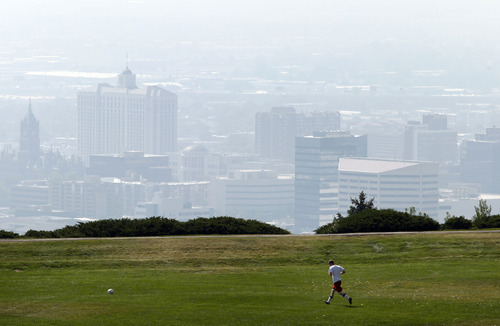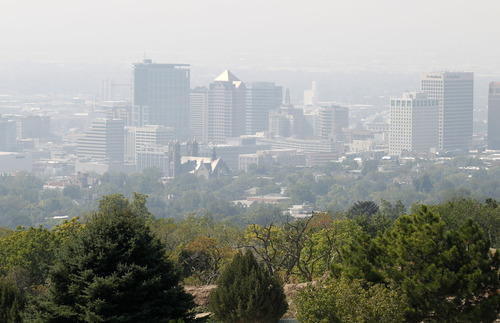This is an archived article that was published on sltrib.com in 2012, and information in the article may be outdated. It is provided only for personal research purposes and may not be reprinted.
Wildfire smoke — and the growing threat to health from it — prompted state air-quality officials Tuesday to issue "red" advisories for much of northern Utah.
The warning brings attention to the health risks for sensitive people, including the very young, the very old and people with heart and lung trouble. It covers Salt Lake, Davis, Weber, Utah, Tooele and Box Elder counties.
A "yellow" advisory is in effect for Uintah County.
"Persons with existing heart or respiratory ailments should reduce physical exertion and outdoor activity today," says the state's advisory, issued Tuesday morning. "Hazy, smoky conditions in northern Utah valleys continue due to upper air transport of smoke from fires that continue to burn in California and Idaho."
A half dozen large fires currently burning in central and northern Idaho are contributing to the smoke that has settled over northern Utah. The Mustang Complex Fire, consisting of six fires in Lemhi County, has burned more than 327,000 acres and is only 20 percent controlled, according to the U.S. Forest Service's Active Fire Mapping Program.
The Mcguire Complex Fire has burned 33,017 acres in Idaho County and is only 2 percent controlled.
Bo Call, who oversees air monitoring for the Utah Division of Air Quality, said it appears the smoke is here to stay for a while in light of the weather conditions now and in the near-term forecast.
"If we don't get some weather to flush this out," he said, "it's going to be grungy like this for a while."
Monica Traphagan, lead forecaster at the National Weather Service's Salt Lake City office, said a ridge of high pressure will likely keep the air stagnant until sometime Friday.
"As we get to Friday afternoon to evening," she said, "the ridge will move itself far enough east so we're on the back side of the ridge and that will give us a southerly flow and that will clear out the smoke."
The long-term forecast shows a storm system may move into Utah next Monday, possibly bringing rain and cooler temperatures, Traphagan said.
Microscopic particulate pollution is mainly soot from combustion, mixed with other chemicals, that is most common in Utah during winter inversions. Wildfire smoke and clouds from fireworks are typically the cause of PM 2.5 pollution in the summer.
PM 2.5 levels began rising Monday afternoon. They were within the "unhealthy" range through the night and into Tuesday morning. Once it reaches concentrations of 35 micrograms per cubic meter of air, the U.S. Environmental Protection Agency regards PM 2.5 pollution as "unhealthy."
For more information about air quality, including current PM 2.5 levels, can be found at http://www.airquality.utah.gov.
Twitter: @judyfutah
Anne Wilson contributed to this story.







